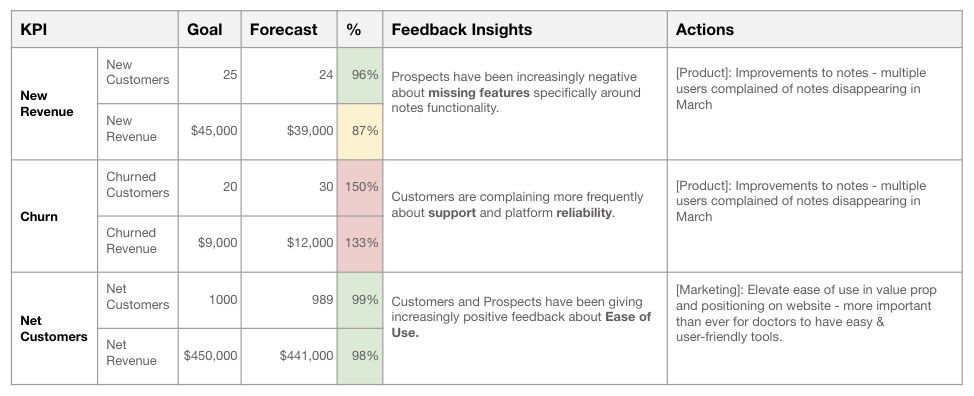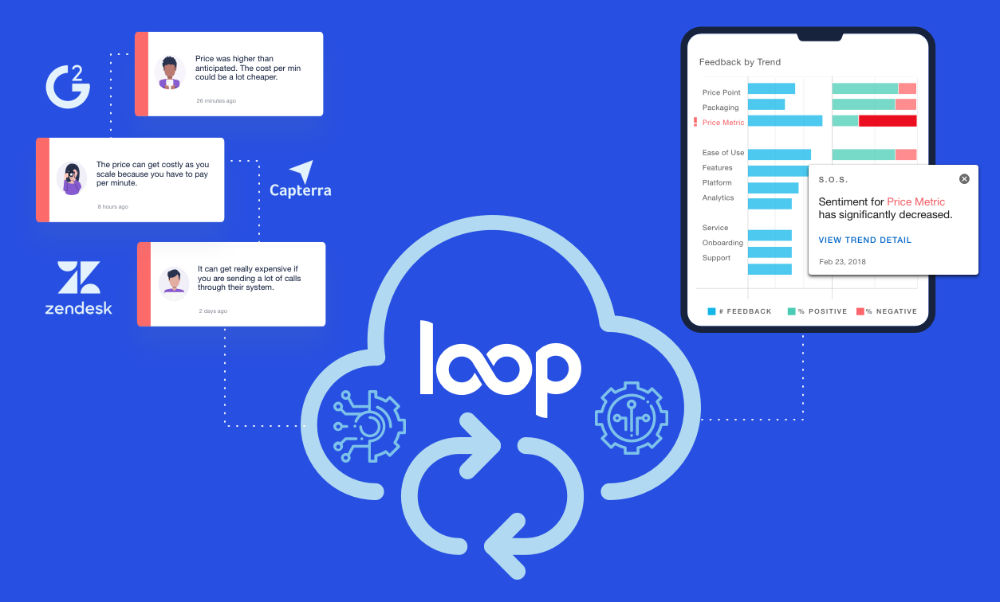Home » Measuring Risks to Revenue and Retention with Text Sentiment Analysis
Measuring Risks to Revenue and Retention with Text Sentiment Analysis
Madeline Turner

B2B SaaS companies are doing everything they can to protect revenue and prevent customer churn. Understanding what customers need and providing value quickly is always important, but right now especially. Teams must work together cross-functionally to both analyze and act on customer feedback in meaningful ways.
Sentiment analysis of customer feedback is important to understanding the biggest opportunities and threats facing your business.
What is sentiment analysis?
The definition of sentiment analysis is: “the process of identifying and categorizing opinions expressed in a piece of text, especially in order to determine whether the attitude towards a particular topic, product, etc. is positive, negative, or neutral.”
Going beyond sentiment analysis basics:
To get to the root of the key issues impacting retention and revenue, we have to take this a step further than text sentiment analysis. In addition to labeling sentiment, we recommend labeling each piece of feedback into key topics so that you can identify primary trends across the customer journey.
Before you begin, make sure that your analysis is representative of all customer feedback channels: qualitative customer interviews, NPS feedback, win/loss and opportunity notes, support tickets, satisfaction surveys, chat, online reviews, and social. By bringing all of your customer feedback together in one place, you’re able to get a more accurate picture of feedback and sentiment trends across the entire experience.
We also recommend looking at feedback over time so that you can understand how sentiment is changing — is something an ongoing trend or was there a specific instance that contributed to a spike in positive or negative feedback?
Bucket feedback into topics that represent attributes of your business or product:
- Pricing: feedback related to price sensitivities and packaging
- Features: feedback related to product capabilities
- Platform: feedback related to stability, accessibility, and integrations
- Ease of use: feedback related to interface adaptability
- Support: feedback related to issue resolution
- Responsiveness: feedback related to how easy your team is to do business with
- Onboarding: feedback related to customers getting started and receiving value
Using sentiment analysis scores to identify risks and opportunities
For this exercise, we recommend using positive and negative feedback labels to help you focus on the areas where action can contribute the most value for your customers and your business. This will also help you understand quickly where customers place the most value.
Once you’ve labeled each piece of qualitative feedback by topic and sentiment, your feedback will be given a sentiment analysis score to designate the impact and importance of the topic trend.
- Strengths = consistent positive topics
- Weaknesses = consistent negative topics
- Opportunities = topics trending with more positive sentiment over time
- Threats = topics trending with more negative sentiment over time
After you’ve identified your strengths, weaknesses, opportunities and threats, your team will want to focus on how to elevate the areas where you’re doing well (updating value positioning) and focus on improving where there are weaknesses and threats.
Taking action, specifically during these times of uncertainty, should be focused on providing as much value to customers as quickly as possible. Willow Moellering of Customer Imperative shares:
“I also love to look at impact/effort and effect of the overall Customer Journey. Normally there are a couple quick wins that might not be a big lift on the Products team and an impact effort matrix will bring those forward.”
Aligning teams around trending topics and actions needed
We recommend putting together a Voice of Customer Report to align teams around the trending topics, areas of opportunity and risk, and actions needed to address. We created this template for you to use, but we also provide direction for creating one of your own below.
Start with a high-level overview of your business health: New Revenue, Churn, and Net Customers. Level-set around the specific KPI for each revenue stream by listing the goal, forecast and % to goal.
For each revenue stream, include related customer feedback insights impacting the goal and recommended actions to take. Here’s an example of a Revenue Scorecard:

Break down by topic and sentiment analysis results
It’s important to give context to issues so that all teams understand the full scope of the recommended actions.
Point out where you’re moving in the right direction and share wins so that you can capitalize on the momentum. For example, if Ease of Use is trending positive, think about using direct verbatim feedback in your marketing copy so that you are speaking in the terms that your customers are using. Voice of customer copywriting is a great way to create messages that drive action and results quickly.
For topics that are trending negative over time, you need to understand and portray the contributing factors — what is the real threat? Segment by the area of revenue impact. Is the negative sentiment reflected across customer and prospect feedback? Or is it specific to one customer type? Who the feedback is coming from is critical in understanding how to address because our approach changes based on segment.
Last, make sure that you’re exploring all options to address the issue in real-time to have an immediate impact.
- Are there MVP options available until long-term solutions are ready?
- Can you offer white-glove service to customers experiencing the greatest impact?
- Are there projects or work that can be halted in order to refocus resources to the greatest need?
Cross-Functional Collaboration
Every team within your company contributes to the customer experience. This means that the actions you take should involve stakeholders from every team — it’s an all-hands on deck approach.
Using sentiment analysis to understand the root of customer issues is a major step in aligning business strategies to customer value. Measuring the impact of actions is the next step, and we’ll be sharing more on closing the loop and tracking impact in our next blog post.




